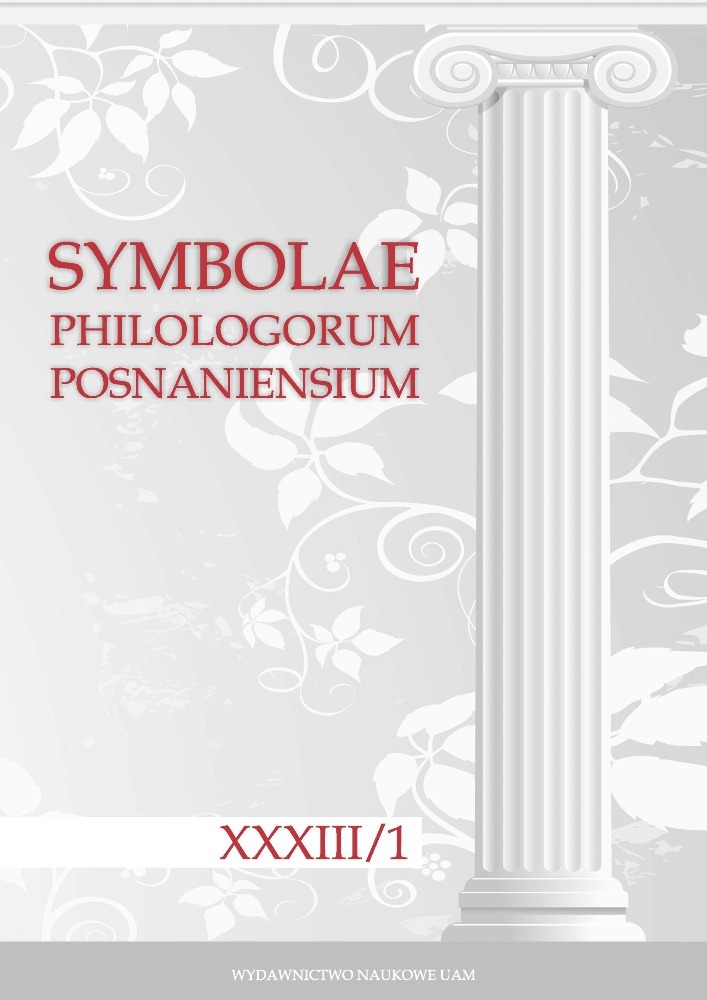Abstrakt
The extensive use of plant motifs is at the heart of Pindar’s poetic images and metaphors. In his epinicions, the poet uses the symbolism of plants associated with Olympian and Pythian games to praise the victor and to show the importance of his achievement. The olive and laurel wreaths with which the victorious athletes are crowned become symbols of excellence and of the immortal fame accompanying human achievements, which is guaranteed by the poet’s song. Spring flowers such as roses and violets have a specific ritual meaning in Pindar’s cult songs, especially in his dithyrambs, where they symbolize vitality and rebirth. Aside from the plants typical of Greek flora, the Theban poet mentions those with miraculous properties, distinguished by their golden colour, which are associated with the divine and characteristic of sacred places and mythical landscape with paradisical connotations. Therefore, the symbolic meaning of floral imagery in Pindar’s Laments and in some passages from his victory songs cannot be recognized without taking into account its eschatological context.
Bibliografia
Bacchylidis carmina cum fragmentis, post B. Snell ed. H. Maehler, Leipzig 1970.
P. Giannini, Olimpica sesta, w: Pindaro, Le Olimpiche, Introduzione, testo critico e traduzione di B. Gentili, commento a cura di C. Catenacci, P. Giannini e L. Lomiento, Milano 2013, 137–165; 445–474.
YMNOI OMHPIKOI czyli Hymny homeryckie, tekst, przekł., wstęp i oprac. W. Appel, Toruń 2001.
Pindar, Wybór poezji, oprac. A. Szastyńska-Siemion, Wrocław–Warszawa–Kraków–Gdańsk–Łódź 1981.
Pindar, The Olympian and Pythian Odes, with an Introductory Essay, Notes, and Indexes, by B.L. Gildersleeve, New York 1982.
Pindar, Ody zwycięskie: Olimpijskie, Pytyjskie, Nemejskie, Istmijskie, przekł., wstęp i komentarz M. Brożek, Kraków 1987.
Pindari carmina cum fragmentis, post B. Snell ed. H. Maehler, pars I: Epinicia, Leipzig 1987; Pars II: Fragmenta, Indices, Leipzig 1975.
Pindaro, Le Olimpiche, Introduzione, testo critico e traduzione di B. Gentili, Commento a cura di C. Catenacci, P. Giannini e L. Lomiento, Milano 2013.
Pindaro, Le Pitiche, Introduzione, testo critico e traduzione di B. Gentili, Commento a cura di P. Angeli Bernardini, E. Cingano, B. Gentili, P. Giannini, Milano 1995.
Pindarus, Threnorum Fragmenta, ed. M. Cannatà Fera, Roma 1990.
Sappho et Alcaeus, Fragmenta, ed. E.-M. Voigt, Amsterdam 1971.
Scholia vetera in Pindari carmina, vol. I–III, ed. A.B Drachmann, Lipsiae 1903–1927.
The Homeric Hymn to Demeter, ed. by N.J. Richardson, Oxford 1979.
Boeke: 2007: H. Boeke, The Value of Victory in Pindar’s Odes. Gnomai, Cosmology and the Role of the Poet, Leiden–Boston 2007. DOI: https://doi.org/10.1163/ej.9789004158481.i-230
Bowra 1964: C.M. Bowra, Pindar, Oxford 1964.
Brenk 1999: F.E. Brenk, Clothed in Purple Light. Studies in Vergil and in Latin Literature, Including Aspects of Philosophy, Religion, Magic, Judaism, and the New Testament Background, Stuttgart 1999.
Bresson 1979: A. Bresson, Mythe et Contradiction. Analyse de la Ville Olympique de Pindare, Paris 1979. DOI: https://doi.org/10.3406/ista.1979.1016
Bridgman 2005: T.P. Bridgman, Hyperboreans. Myth and History in Celtic-Hellenic Contacts, New York–London 2005. DOI: https://doi.org/10.4324/9780203487655
Calame 2013: C. Calame, The Dithyramb, a Dionysiac Poetic Form: Genre Rules and Cultic Context, w: Dithyramb in Context, eds. B. Kowalzig, P. Wilson, Oxford 2013, 332–352.
Cook 1900: A.B. Cook, Iostephanos. Why was Athens called the City of the Violet Crown, „Journal of Hellenic Studies” 20 (1900), 1–13. DOI: https://doi.org/10.2307/623737
Danielewicz 1996: Liryka starożytnej Grecji, oprac. J. Danielewicz, Warszawa–Poznań 1996.
Danielewicz 1999: Liryka grecka, t. II: Melika, oprac. J. Danielewicz, Warszawa 1999.
Darchia 2000: I. Darchia, Phenomenon of Colour in the Poetry of Pindar, „Phasis” 2–3 (2000), 87–94.
Eliade 1988: M. Eliade, Historia wierzeń i idei religijnych, t. I: Od epoki kamiennej do misteriów eleuzyńskich, tłum. S. Tokarski, Warszawa 1988.
Friis Johansen 1959: H. Friis Johansen, Eine Dithyrambos-Auffürung, Copenhagen 1959.
Hamilton 1990: R. Hamilton, The Pindaric Dithyramb, „Harvard Studies in Classical Philology” 93 (1990), 211–222. DOI: https://doi.org/10.2307/311286
Irwin 1996: M.E. Irwin, Evadne, Iamos and Violets in Pindar’s „Sixth Olympian”, „Hermes” 124 (1996), 385–395.
Kaczor 2001: I. Kaczor, Kult drzew w tradycji mitologicznej i religijnej starożytnych Greków i Rzymian, Łódź 2001. DOI: https://doi.org/10.18778/1505-9057.03
Nagy 1979: G. Nagy, The Best of the Achaeans. Concepts of the Hero in Archaic Greek Poetry, Baltimore–London 1979.
Paton 1911: W.R. Paton, The Golden Bough, „The Classical Review” XXV (1911), 205.
Podlecki 1984: A.J. Podlecki, The Early Greek Poets and Their Times, Vancouver 1984. DOI: https://doi.org/10.59962/9780774857628
Rzymowska 2001: L. Rzymowska, Piersi fiołkami pachnące. Kwiaty w mitach i języku dawnej Grecji, w: Świat roślin w języku i kulturze, red. A. Dąbrowska, I. Kamińska-Szmaj, Wrocław 2001, 51–66.
Salvador 1997: J.A. Salvador, Iamus and ἴα in Pindar („O”. 6.53–57), „Quaderni Urbinati di Cultura Classica” 56 (1997), nr 2, 37–59. DOI: https://doi.org/10.2307/20547394
Segal 1981: C. Segal, Myth, Cult, and Memory in Pindar’s Third and Fourth Isthmian Odes, „Ramus” 10 (1981), 69–86. DOI: https://doi.org/10.1017/S0048671X00005348
Segal 1986: C. Segal, Pindar’s Mythmaking. The Fourth Pythian Ode, Princeton 1986. DOI: https://doi.org/10.1515/9781400853106
Schönbeck 1962: A. Schönbeck, Der locus amoenus von Homer bis Horatz, Heidelberg 1962.
Sfyroeras 2018: P. Sfyroeras, Pindar at Colonus: A Sophoclean Response to Olympians 2 and 3, w: Paths of Songs. The Lyric Dimension of Greek Tragedy, eds. R. Andújar, T.R.P. Coward, T.A. Hadjimichael, Berlin–Boston 2018. DOI: https://doi.org/10.1515/9783110575910-005
Slater 1969: W.J. Slater, Lexicon to Pindar, Berlin 1969. DOI: https://doi.org/10.1515/9783110839289
Willcock 1995: M.M. Willcock, Pindar. Victory Odes, Cambridge 1995.
Worman 2015: N. Worman, Landscape and the Spaces of Metaphor in the Ancient Literary Theory and Criticism, Cambridge 2015. DOI: https://doi.org/10.1017/CBO9781139032827


